891 Search Results for core vocabulary
March 10, 2015
by Carole Zangari -
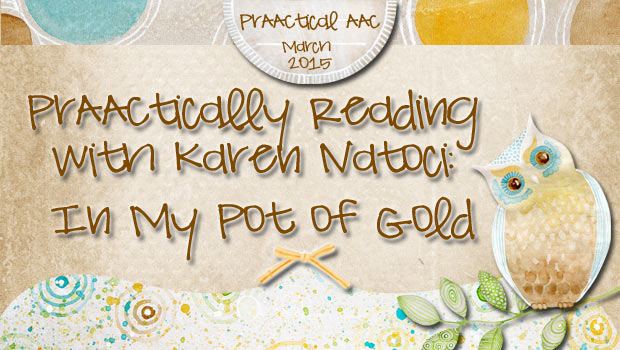
It’s green where we live, but even our friends who’ve been battling snow and ice for far too long (!) have been seeing bits of color…IF you count the rainbows and gold-filled pots in their therapy rooms, offices, and classrooms. St. Patrick’s Day can be a fun, playful holiday to celebrate, and there are plenty of thematic materials around to build language and literacy skills. For some learners, acquiring holiday-related vocabulary. like shamrock and leprachaun, makes sense. But for most of the AAC learners with whom we work, the priorities are elsewhere. That’s one reason that I’m delighted to share Karen Natoci’s PrAACtically Reading for March. As always, Karen is incredibly generous in sharing both information and materials (such as her lesson plan and PowerPoint story). What I love most about her post, though, is that it honors the excitement and traditions of the holiday while keeping focused on the goal of building core... [Read More...]
March 8, 2015
by Carole Zangari -
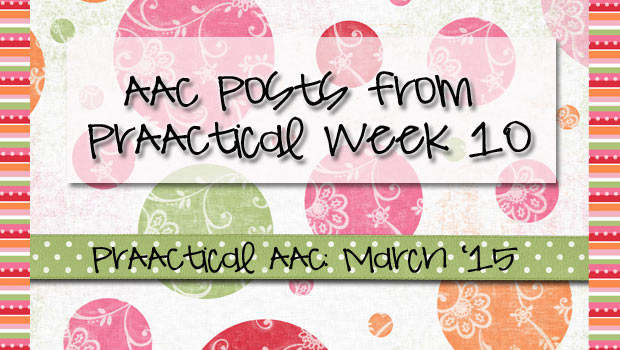
Monday: Speaking in Core – Sentences for March Words Tuesday: Resources for A Year of Core Vocabulary – March Words Wednesday: Watch It Wednesday – AAC in Early Childhood Thursday: Growing Our Ranks – An AAC Confessional
March 5, 2015
by Carole Zangari -
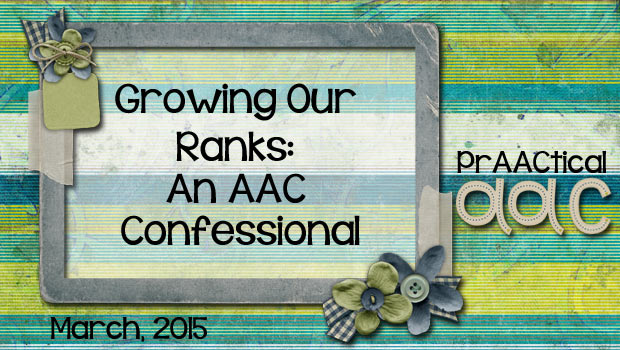
It’s funny where life takes you. A former student of mine was unhappy as an attorney, but found deep satisfaction in becoming an SLP. Another one enjoyed her work as an SLP, but reached even more lives by founding a company for low tech communication and literacy materials. As SLP students, we might not have considered the role that people with AAC needs would play on our caseloads. And with over 90% of school-based SLPs serving kids with autism, my guess is that many who are now supporting nonverbal or minimally verbal students had no intention of specializing in AAC. And yet, there they are: a language lifeline for students who cannot communicate effectively through speech. I am so grateful to today’s guest author, Sara Barnhill, for sharing her own experience in becoming an AAC service provider. Sara is an SLP who has has worked at Children’s Hospital of Richmond at... [Read More...]
March 1, 2015
by Carole Zangari -
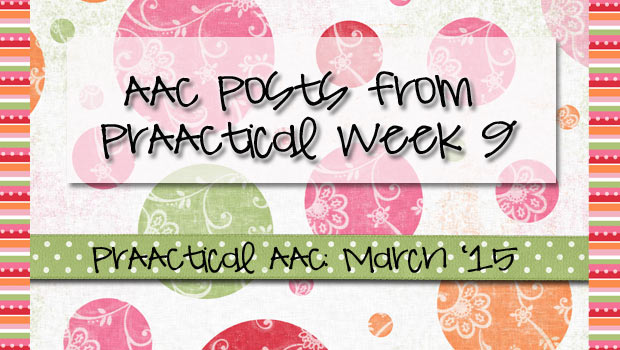
Was it a busy week where you live? Here are some AAC posts you may have missed. Monday: Magic Moments with Word Clouds Tuesday: Teach Me Tuesday: TalkRocket Go by My Voice Wednesday: Video of the Week – Communication Supports for People with Rett Syndrome Thursday: Strengthening the Core: Getting Ready for March Core Vocabulary
February 19, 2015
by Carole Zangari -
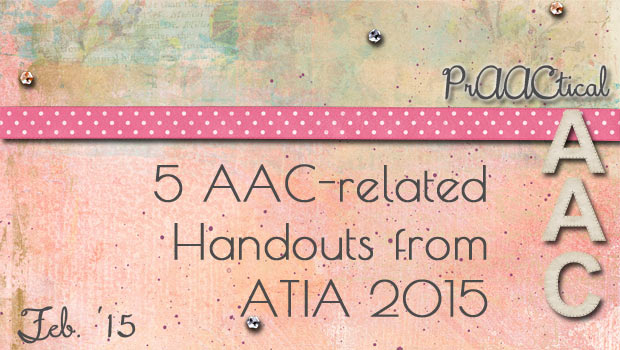
The 2015 ATIA conferences was one of the strongest in recent memory, with lots of AAC presentations to choose from. As you can see, I had a blast! There was AAC in every direction, from the Town Hall Meetings, App Smackdowns, expanded poster sessions, traditional sessions, and, of course, the exhibit hall. If professional development in AAC is a priority for you, be sure to put the 2016 conference (in Orlando) on your radar for February 2-6, 2016. In the meantime, here are some of the handouts to whet your appetite. Lori Wise and Marlene Sotelo’s terrific talk on using iPads to build social engagement with people who have ASD along with their app lists here and here was one of my favorite presentations of the conference. [Note: Their handouts are hosted on the ATIA conference site and may only be available for a limited time. Grab them while you can!] Gretchen... [Read More...]
February 17, 2015
by Carole Zangari -
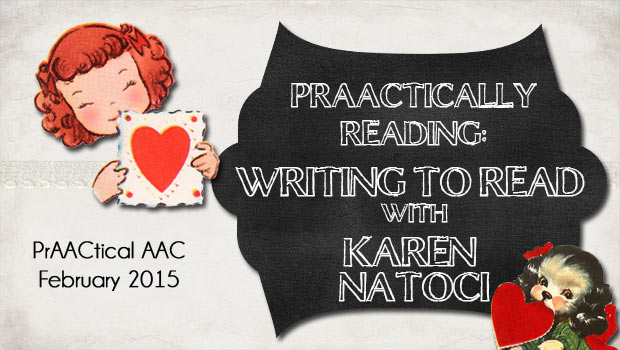
We are so pleased to have SLP Karen Natoci back with the second edition of PrAACtically Reading. You can see her first post here. I love that this lesson focuses on older students, providing an age respectful activity (who else loves Mad Libs?!) and a prAACtical way for students with lower verbal skills to develop their reading abilities. Writing to Read: Mad Lib, Core Words, and Literacy Instruction Core Vocabulary focus: like, dislike, uh-oh, again Sometimes it is fun to just write our own BIG BOOK and this month, we decided to do that by using a simplified “mad libs” format. Honestly, I’m not sure who had more fun, the teachers, the student authors or myself! I was inspired by the work of Gretchen Hanser. I attended her workshop on writing at Oakland Schools (MI) in the fall of 2013. She showed us that all students develop writing and experience... [Read More...]
February 12, 2015
by Carole Zangari -
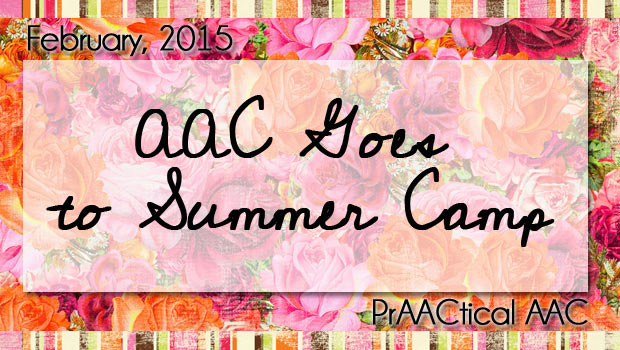
Those of you who are still digging your way out of the most recent snowstorm may not believe it, but it’s almost time to make plans for summer. There are quite a few AAC camps, some that are quite well established and others that have been running for only a few years (see our AAC Camp Pinterest board here). In this post, we hear about one of them from Tina Moreno, an SLP and mom of Mateo, who uses PicturePower 100 on the Maestro to communicate, maintain friendships with his teammates on the cross country team, advocate for himself, reveal his wicked sense of humor, and even sing the National Anthem for his high school’s basketball games. Tina blogs at Voices4All. With the help of Drs. Karen Erickson and David Koppenhaver, she and her friend Gina Cunningham created Camp ALEC together in memory of Gina’s son Alec, who never gave up, and... [Read More...]
February 9, 2015
by Carole Zangari -
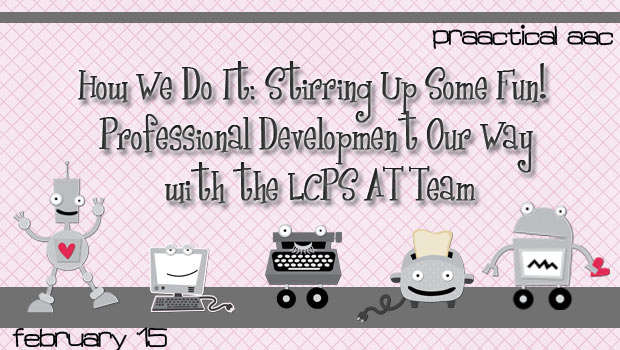
How does the AT team at Virginia’s Loudoun County Public Schools (LCPS) set out to influence their colleagues to learn more about AAC? With digital technologies, of course, along with a heaping dose of fun. In this post, OT Judith Schoonover and SLP Sally Norton Darr share some of the team’s favorite strategies for professional development. Judie has practiced in schools since 1975, working as an OT, elementary school teacher, and an AT trainer in that time. She is a strand advisor for ATIA, and has authored chapters and presented nationally on topics including UDL, adapting books, the relationship between OT and AT, and low tech supports for students. Sally is an SLP and AT trainer for LCPS. She enjoys her work in the public schools and has fun presenting internationally, regionally, and virtually to diverse audiences on a wide range of low to high-tech strategies, interventions, and solutions. Sally is the... [Read More...]
January 8, 2015
by Carole Zangari -
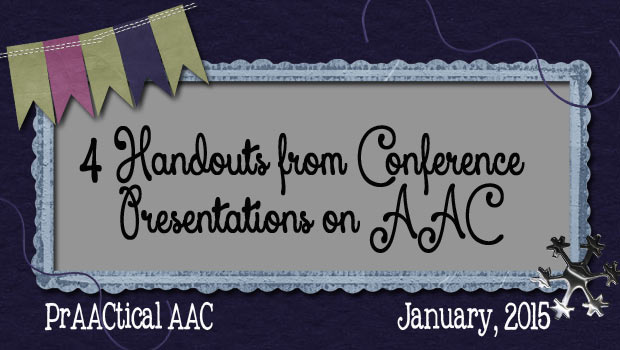
Travel budgets are limited these days and we can’t always get to the conferences we’d love to attend. In case that happens to you, too, here are some presentation handouts on AAC-related topics from ISAAC 2014, ASHA 2014 and other conferences. Gloria Soto, Dan Phillips, and Michaela Sullivan on Strategies for SLPs Working With Students With AAC Needs in Schools Gretchen Hanser on Writing for Students with Angelman Syndrome Penny Hatch and Allison Dennis on Getting to the Core: Creating a Core Vocabulary for the Common Core Amy Wetherby on the trajectory of development for toddlers with developmental disabilities
January 5, 2015
by Carole Zangari -
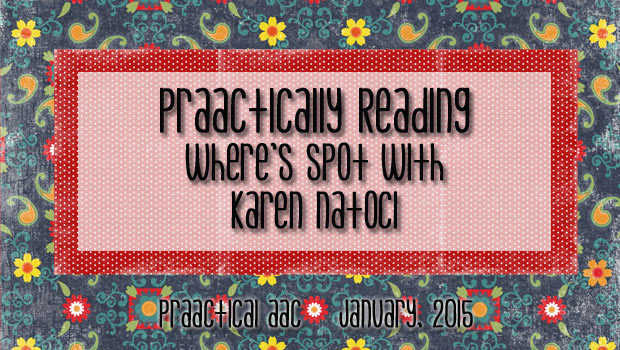
New years bring new opportunities. Today, we welcome back Karen Natoci, but this time in a new role. Karen will be doing a monthly post sharing ideas for interactive book reading with children who use AAC. In her first PrAACtically Reading post, Karen explains how she used book reading to build language and literacy skills. ::::::::::::::::::::::::::::::::::::::::::::::::::::: We had a wonderful time reading Where’s Spot? By Eric Hill. I had both the “big book” and a small, cardboard book. Most all of the pages contain a predictable line: “no!” Since many of my students were learning to say “yes/no” it seemed like a great way to practice this skill as part of SHARED READING. The important part is that everyone in the classroom had access to some form of AAC, including the staff. So, while I was reading the story, I paused and the whole class responded together by using their AAC... [Read More...]









